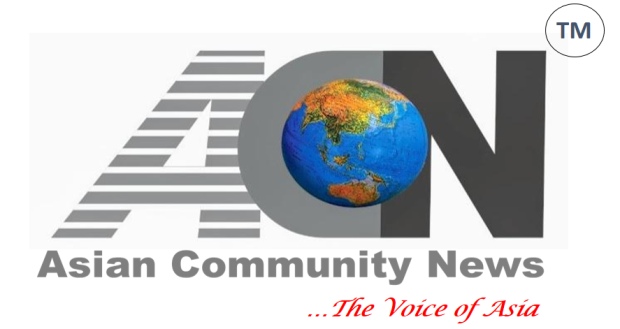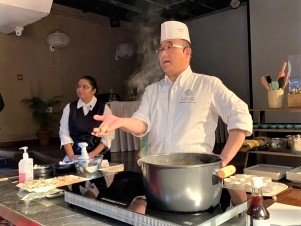Japan successfully introduces Washoku – traditional Japanese food culture in India
Registered as a UNESCO Intangible Cultural Heritage, the Washoku is a traditional Japanese dietary culture based on respecting nature.
NEW DELHI: In back-to-back events featuring an elaborate range of traditional Japanese food including sushi, sake, and much more, Japan very aptly introduced Washoku – its traditional Japanese food and food culture in India on the occasion of Japanese Food Day, the November 24. This initiative forms the part of the ongoing celebrations of the 70th Anniversary of the establishment of diplomatic relations between India and Japan.
Besides organising India-Japan Symposium on Food and Agriculture, Japan Embassy along with its allied agencies such as JETRO, and others also staged reception serving elaborate Japanese cuisines including vegetarian sushi. And most important was Japan’s way of extending support to India for celebrating the year 2023 as the International Year of Millet. Renowned Japanese chefs prepared and served Japanese food made with millet at Japan Embassy, New Delhi. Japan Ambassador to India Hiroshi Suzuki played host to this grand Japanese food reception.
The Japanese food festivities took off in New Delhi on November 24, which is celebrated as Japanese Food Day in Japan. The Embassy of Japan in India organised four events to celebrate Japanese Food Day on 24 November and to promote Japanese food and food culture, including sake. In particular, since 2023 is the International Year of Millet (IYOM), Japanese food with rich millet was served at the reception in the evening of 24 November, in addition to the vegetarian Japanese cuisine, to deepen culinary culture exchange between Japan and India.
The India-Japan Symposium on Food and Agriculture – Sustainable Food Supply and Agricultural Investment was organised by the Ministry of Agriculture, Forestry and Fisheries of Japan, together with the Embassy of Japan in India in partnership with the Ministry of Agriculture and Farmers Welfare of India, Ministry of Food Processing Industries of India. The event was supported by JETRO, CII, and FICCI.
The symposium was organised with the aim of building a network between the agricultural and food industry stakeholders in India and Japan with a view to implement investment and export targets, such as Japanese investment and loans to India of JPY 5 trillion and worldwide exports of Japanese food of JPY 5 trillion by 2030.
 The opening session of the symposium was attended by OGAWA Ryosuke, Vice-Minister for International Affairs, Ministry of Agriculture, Forestry and Fisheries, and NAKAJO Kazuya, Executive vice president of JETRO, and KAWAZU Kunihiko, Chargé d’affaires ad interim of Japan to India.
The opening session of the symposium was attended by OGAWA Ryosuke, Vice-Minister for International Affairs, Ministry of Agriculture, Forestry and Fisheries, and NAKAJO Kazuya, Executive vice president of JETRO, and KAWAZU Kunihiko, Chargé d’affaires ad interim of Japan to India.
In addition to the promotion of investment and exports, KAWAZU expressed his hope that the symposium would provide an opportunity to strengthen ties between the two countries under the presidency of the next G7 (Japan) and G20 (India) respectively. He also expressed his expectations for further people-to-people exchange in the agricultural and food industry sectors through the Technical Intern Training Program (TITP) and the Specified Skills Worker Program (SSW).
The symposium included four sessions on the following themes, where speakers from both India and Japan introduced their initiatives and shared their knowledge on how to develop business and strengthen cooperation in the agricultural and food industries sector between India and Japan. These session were Enhancing business collaboration in India, Possibility of new technologies and methods for enhancing productivity, India-Japan roles for global system of sustainable food and agriculture, and Deployment of advanced methods in rural India.
In the closing session, Saito Mitsunori, Chief Representative of JICA India Office, and Wakamori Susumu, Chairman of the Japanese Chamber of Commerce and Industry in India (JJCCI), India head of MARUBENI expressed their expectations for further development of both business and G to G cooperation in the agricultural and food industries sector between India and Japan in the near future.
 Then followed a Reception for industry-academia-government exchange in the food and agriculture sector. Following the symposium, a networking event for industry, academic and government leaders was held at the same venue. The event was attended by about 200 participants from the symposium and about 80 people from 15 exhibiting companies/groups.
Then followed a Reception for industry-academia-government exchange in the food and agriculture sector. Following the symposium, a networking event for industry, academic and government leaders was held at the same venue. The event was attended by about 200 participants from the symposium and about 80 people from 15 exhibiting companies/groups.
At the venue, there were opportunities to learn about Japanese food and food culture, including demonstrations on authentic nigiri-sushi ‘Vegetable Sushi’ that vegetarians can also enjoy (lecturer: TEZUKA Yoshinori, fourth-generation owner of Matsunozushi in Tokyo, Sushi ambassador) and workshops on ‘Umami’ (lecturer: Professor ICHIMAIDA Kiyoyuki of Hattori College of Nutrition). They were tasting Japanese food such as Ramen and Japanese-style Curry, as well as an exhibition of Japanese food products.
The event also included the unveiling and tasting of the first cargo of Japanese apples that arrived in India after lifting the import ban, where participants enjoyed its rich aroma and juicy taste. There was a Japanese sake tasting corner, which also offered “craft sake”, Japanese wine from Yamanashi Prefecture and Japanese whisky.
Following the symposium and the networking event, an Evening of India-Japan Culinary Culture Exchanges was held at the Embassy of Japan in India.
At this reception, in addition to the vegetarian Japanese food, Millet cuisine from Japan and India were introduced, taking into account that 2023 is the International Year of Millet (IYOM), as proposed by India at the UN General Assembly.
The Indian Minister for External Affairs, Dr. S. Jaishankar, was invited as the chief guest to celebrate the 70th anniversary of the establishment of diplomatic relations between India and Japan, and to taste the vegetable sushi and Japanese cuisine with Millet.
 Also, Japanese apples and shiitake mushrooms (from Takachiho, Miyazaki Prefecture, Japan and provided by Sugimoto Corporation), an essential ingredient of broth for vegetarian Japanese cuisine, were also displayed.
Also, Japanese apples and shiitake mushrooms (from Takachiho, Miyazaki Prefecture, Japan and provided by Sugimoto Corporation), an essential ingredient of broth for vegetarian Japanese cuisine, were also displayed.
On November 25, Japanese Food Day Lectures and Demonstrations followed at the Institute of Hotel Management, Catering and Nutrition, Pusa. It was supported by S.A.A.G., Sugimoto Corporation.
At the Institution of Hotel Management, Catering and Nutrition, PUSA, a lecture and demonstration for Washoku (Japanese Food) Day was organised for about 150 people, mainly students from IHM Pusa, by Sushi ambassador TEZUKA Yoshinori and Professor ICHIMAIDA Kiyoyuki.
The lecture and demonstration were the first opportunity for the students, most of whom are expected to study culinary arts and become chefs in the future, to sea cooking of Japanese food.
Renowned Chef Tezuka gave a lecture and a demonstration with the theme of the history of Japanese food with the focus on sushi, and told how to make rice for sushi (it’s called “shari”), the characteristics of sushi vinegar and how to handle a knife, while Chef KATAGIRI Kensaku (Chef of Haus St Anton in Nagano Prefecture), who accompanied him as an assistant explained how to prepare and cook vegetables for vegetable sushi
Professor Ichimida gave a lecture on ‘Dashi’ with a demonstration on the differences between kombu seaweed, bonito and shiitake mushroom and the synergistic effect of the umami by combining them through tasting. He also explained about the composition of Japanese cuisine (“Kaiseki cuisine”).



